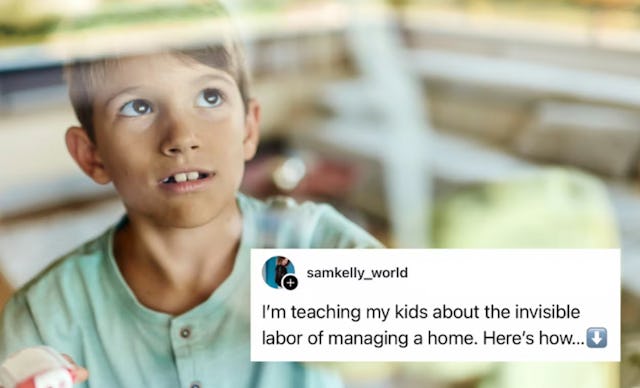This Mom Is Teaching Her Kids About Invisible Labor Early — Here’s How
Instead of a chore chart, they practice “Notice and Do” tasks.

Before we had the term ‘invisible labor,’ I carried the ambiguous sense of it. An awareness that the whole responsibility of motherhood is more exhausting than the sum of its tasks. Once we could name it, it felt like everyone was talking about the extra effort of anticipation, planning, execution, and management that go into running a household. The recognition was so validating! The thing is, recognition — “Thanks for all the invisible labor, Mom.” — isn’t enough.
Imagine saying “Thanks for all you do, Mom!” from the couch while watching your mother struggle to carry a heavy piece of furniture upstairs. It looks difficult, even dangerous, to do alone. But she can probably manage fine, she did sign up to be a mom after all. So you turn back toward the TV.
Most of us acknowledge that allowing our mother to be crushed by an unwieldy object is, at the very least, bad manners. When you recognize a heavy load, you offer help. Better yet, you see where the load is slipping, secure your grip, and carry it up the stairs together. We need to set the same expectation for invisible labor.
Sam Kelly, who happens to be a therapist and mom of 3, is doing exactly that. Kelly outlined details on her Threads account. And the way she’s approaching teaching invisible labor (and how to balance it fairly) to her kids is downright inspiring.
“I’m teaching my kids about the invisible labor of managing a home. Here’s how,” she begins her thread.
“I’m having on-going conversations with them about what invisible labor is, what it means, and examples of what it looks like in both their lives and mine. (For reference: my kid’s ages are 12, 10, and 6.)”
She begins with the basics. “I started teaching them that the very first step in anything getting done around the house (including chores) is NOTICING that something needs to get done and then doing it.”
It’s so simple, yet it’s probably not a conversation that many of us have had with our kids before.
Kelly explains why help with chores and chore charts aren’t enough.
“Traditional chore charts reinforce the skipping over of the first, crucial step of task execution — the noticing — and defaults that emotional labor onto me, their mom/the woman, to carry the load of knowing what needs to get done and then doing the work of assigning tasks,” she explains. Brilliant!
“With this in mind, we’ve flipped the script of the traditional chore chart. Instead of chores, we do our…NOTICE AND DO’S.”
The reframing is simple, but game-changing.
“I’m teaching my kids how to first, notice what needs to be done around the house and then take the initiative to actually do it on their own. This might seem like a crazy fantasy pipe dream. I get it. But slowly, over time…it’s working.”
Of course, we aren’t born with the skills and cognitive abilities to manage a household. It takes repetition and practice.
“The goal is to help them build strong enough ‘Notice and Do’ muscles that they’ll eventually be able to participate in shouldering the mental load (in age-appropriate ways) of knowing what needs to be done around the house without needing me to assign them a job/task,” she continues.
“Long term, the goal is for my kids to not only have awareness of what goes on behind the scenes of managing a home/life but also have developed the proactive, self-motivational skills to take responsibility for doing it themselves.”
Kelly also addresses the gender norms associated with invisible labor.
“I’m setting up my daughters to understand that invisible labor is not their job, as girls/eventually women, to manage alone. Carrying the vast majority of a family’s mental load is not meant to be their default setting simply because society expects it of them,” she explains.
“I’m setting up my son to understand that he is just as capable of noticing what tasks need to be done in a home as his sisters/mom. ‘Noticing and Doing’ is just as much of his responsibility as a boy/eventually man. I’m teaching him how to be an aware, engaged team player who actively participated in carrying the invisible labor of a family.”
Um, can she be my mother-in-law, please?
While the ‘Notice & Do’ method isn’t an easy fix, it is a powerful shift. If you’re interested in learning more about how Sam Kelly teaches invisible labor, she created a free guide to implement her home management strategy. Motherhood isn’t going to become a cake walk overnight, but we can invest in our shared future by setting the next generation up for more equitable and sustainable domestic partnerships.